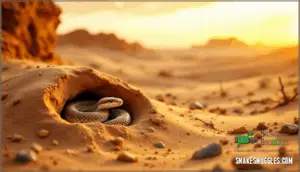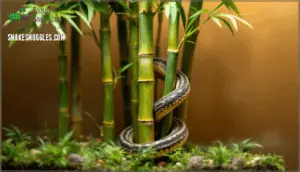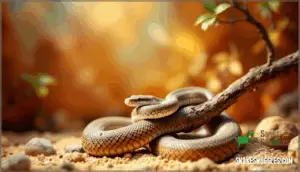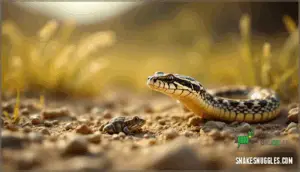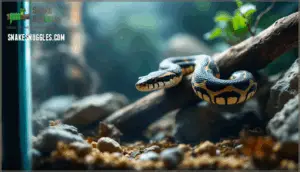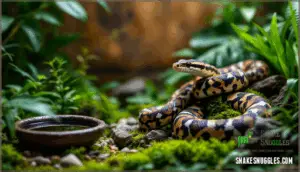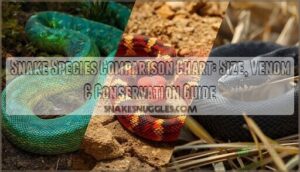This site is supported by our readers. We may earn a commission, at no cost to you, if you purchase through links.

The Kenyan sand boa, for instance, thrives in captivity but demands such specific care that casual keepers often pass. Others like the bamboo rat snake remain genuinely scarce because few people have figured out how to breed them reliably.
Understanding what makes a snake rare—and what that rarity demands from you—separates fantasy from reality when you’re hunting for something truly remarkable.
Table Of Contents
Key Takeaways
- Rarity in pet snakes isn’t just about scarcity—it’s driven by breeding challenges, geographic isolation, import regulations, and limited hobbyist knowledge, making understanding these factors essential before pursuing an unusual species.
- Species like Kenyan sand boas, Children’s pythons, and Western hognose snakes thrive in captivity with proper care, but each demands specific habitat conditions, feeding schedules, and handling approaches that differ significantly from common pet snakes.
- Legal and ethical considerations are non-negotiable—check your local permits, avoid wildlife trafficking by working with reputable breeders, and recognize that nearly a million endangered snakes are illegally sold annually, making responsible sourcing critical.
- Success with rare snakes requires mastering species-specific health management, recognizing early warning signs like respiratory issues (affecting 26-59% of captive snakes) and shedding problems, and committing to consistent veterinary care and proper environmental controls.
What Makes a Snake Breed Rare?
Not all snakes you’ll find at a reptile expo are created equal. Some species remain rare in the pet trade because of where they’re found in the wild, how tough they’re to breed, or simply how few people know about them.
Before you chase down an unusual species, you’ll want to understand what makes it rare and whether you can legally—and ethically—keep one.
Definition of Rare Pet Snakes
A rare pet snake isn’t just hard to find—it’s a species that breaks the mold with unusual traits, limited captive breeding, or restricted geographic origins that keep it off most keeper’s radars.
Think of rarity as a combination of factors: exotic pet trade restrictions, snake hobbyist community demand, and conservation status all play a role.
Understanding snake breed classification and pet snake legislation helps you navigate what makes these unique pet snakes special—and legal.
Factors Influencing Rarity (Geography, Appearance, Availability)
Geography plays a crucial role in determining where snakes can be found. Species from isolated mountain ranges show up to 60% smaller range sizes, making them more challenging to source. These factors significantly influence the availability of certain snake breeds for reptile collections.
Unique morph mutations, such as the "Super Arctic" hognose, account for less than 1% of the market share, driving demand sky-high. Import regulations and breeding challenges further complicate matters. Only 1 in 25 offspring displays rare traits, and CITES permits restrict international sales.
Snake enthusiasts often research snake habitat variations to better understand the needs of their pets. This knowledge is essential for providing proper care and ensuring the well-being of these coveted additions to any reptile collection.
Legal and Ethical Considerations
Before you bring home a rare snake, you need to know the rules. Texas requires a Controlled Exotic Snake Permit for venomous species and large constrictors, while Massachusetts mandates permits for all boas and pythons. Snake Welfare depends on following exotic laws and understanding conservation ethics.
Wildlife trafficking threatens wild populations—nearly a million endangered snakes are sold internationally each year. Always work with a reputable breeder who prioritizes ethical pet ownership and proper snake care practices.
Nearly a million endangered snakes are trafficked annually, so ethical pet ownership demands working with reputable breeders who prioritize conservation over profit
It’s essential to understand the impact of invasive snake species on native ecosystems.
Top Rare Pet Snake Breeds List
You’re about to meet some of the most unique snakes in the pet trade—species that don’t show up in every pet store and offer something different from the usual ball python or corn snake.
Each one brings its own personality, quirks, and care needs to the table. Let’s break down the top rare breeds that could be your next companion.
Kenyan Sand Boa
If you’re hunting for a snake that looks like it borrowed its body plan from a rubber tube and its lifestyle from a desert nomad, the Kenyan sand boa might just steal your heart.
This stocky species thrives in sand substrate and desert habitat conditions, staying buried most of the day. Females reach about 24 inches while males max out around 20.
Their calm snake demeanor makes boa management straightforward, and their boa feeding requirements are simple—just thawed rodents every week or two.
Bamboo Rat Snake
Picture a slender climber that moves through Asian bamboo forests like silk threading through needles—that’s the bamboo rat snake in action. Here’s what makes this reptile collection standout tick:
- Snake habitat requirements: Dense bamboo clusters with vertical climbing space in your terrarium design
- Snake conduct: Nocturnal hunter, prefers elevated hiding spots
- Feeding techniques: Thawed rodents every 5-7 days
- Snake species information: Reaches 4-5 feet, displays striking gray-brown patterns
- Habitat creation: Maintain 75-80°F with moderate humidity
This snake care guide favorite rewards your effort with mesmerizing arboreal displays.
Children’s Python
Don’t let the name fool you—Children’s pythons pack all the personality of their larger cousins into a compact, apartment-friendly package that rarely exceeds three feet. Native to Australia’s northern territories, these python morphs display a calm snake temperament that’s perfect for your first reptile adventure.
Your snake habitat requirements stay simple—an enclosure with proper heating and hiding spots. Snake care guide basics like feeding techniques using appropriately-sized prey keep this pet snake thriving for up to 20 years.
Western Hognose Snake
That upturned snout isn’t just for show—Western hognose snakes use their signature nose to dig through sandy substrates in search of toads and small prey across North America’s grasslands and prairies.
Your hognose care revolves around mimicking this burrowing snake conduct:
- Design your snake habitat with at least 3 inches of loose substrate for digging
- Master feeding tips by offering frozen-thawed rodents when toads aren’t available
- Watch for their dramatic defensive displays—they’ll flatten and hiss before playing dead
This snake species stays under two feet and thrives with proper habitat design.
California Kingsnake
California kingsnakes are the rebels of the snake world—they hunt and eat other snakes, including rattlesnakes, thanks to their natural immunity to venom. Your California kingsnake thrives with varied kingsnake morphs ranging from banded to striped patterns.
Habitat creation demands a secure enclosure since these pet snakes are notorious escape artists. Feeding techniques focus on appropriately sized rodents, and breeding methods have produced stunning color variations.
This snake species exhibits bold snake conduct and adapts well to snake care routines.
Other Noteworthy Rare Breeds
Beyond the usual suspects, several species push the boundaries of what makes a rare breed truly outstanding. These snakes captivate enthusiasts with their unique characteristics and challenges in preservation.
Rosy Boas stand out with their locality-specific morphs, which breeding programs struggle to maintain. Pure-bred specimens are highly valued in a market often dominated by hybrids. Similarly, Carpet Pythons and Milk Snakes showcase explosive color diversity, though certain morphs remain rare and sought after.
Consider these exceptional species:
- Emerald Tree Boas command prices exceeding $700 due to their stunning green coloration and specialized snake habitat design demands.
- Green Tree Pythons transform from yellow hatchlings to emerald adults—subject to exotic pet laws under CITES Appendix II.
- Cape House Snakes from southern Africa offer docile temperaments but fewer than 1,000 reach global markets annually.
Rare breed conservation intersects directly with snake morphology appreciation. While Ball Pythons and Western hognose snakes dominate mainstream markets, these alternatives challenge experienced keepers seeking liberation from the ordinary.
Key Characteristics of Rare Snake Breeds
Rare snake breeds stand out through specific traits that make them fascinating but challenging pets. You’ll notice distinct differences in size, color patterns, temperament, and physical features that set these species apart from common pet snakes.
Understanding these characteristics helps you decide which rare breed fits your experience level and setup.
Size and Lifespan
When you’re shopping for a rare snake, size and lifespan aren’t just numbers on a care sheet—they’re the blueprint for the next decade or two of your life together.
A Children’s python maxes out around three feet and can hit 20 years, while a Kenyan sand boa stays compact at two feet with similar longevity.
Growth rates and maturity stages vary wildly between species, so understanding these age factors helps you plan the right habitat from day one.
Unique Coloration and Patterns
Color morphs are where the magic happens—rare markings and pattern genetics create snakes that look like they were painted by hand. California kingsnakes flaunt banded and striped color patterns, while Western hognose subspecies show off peach, lavender, and albino scale variations.
These snake colors aren’t just eye candy—they’re genetic lottery tickets that affect snake camouflage and reflect wild snake species characteristics in captivity.
Temperament and Handling Needs
A snake’s personality matters just as much as its colors—contact frequency and species temperament determine whether you’ll have a chill companion or a defensive escape artist on your hands.
Children’s pythons and Kenyan sand boas stay calm under pressure, making training techniques straightforward.
Snake conduct varies wildly—gentle species tolerate regular contact while others need aggression management strategies and patience to build trust.
Distinctive Physical Traits (e.g., Upturned Nose)
You’re about to meet snakes that look like they raided nature’s costume closet—upturned snouts, keeled scales, and prehensile tails separate ordinary pet snakes from showstoppers that make your friends do a double-take. Hognose snakes dig with those nose shapes like tiny bulldozers, while color morphs and snake patterns on bamboo rat snakes create optical illusions across their scaly textures.
Body proportions reveal species instantly—Kenyan sand boas pack muscle into stubby frames, proving snake characteristics drive both snake conduct and collector obsession.
Care and Habitat Requirements for Rare Snakes
Setting up the right habitat isn’t optional—it’s the foundation of keeping rare snakes healthy and thriving. Each species has specific needs for temperature, humidity, and enclosure design that you’ll need to nail down before bringing one home.
Here’s what you need to know about creating the perfect environment for your rare snake.
Ideal Terrarium Setup
Setting up the right terrarium for your rare snake isn’t just about picking a glass box—it’s about recreating a slice of their natural habitat where they’ll actually thrive.
Your snake enclosure needs the right size for the species, a secure lid they can’t escape from, and substrate options that match their burrowing habits.
Add hiding spots on both warm and cool ends of the tank, a sturdy water bowl, and enough space to stretch out—that’s your foundation for a proper terrarium setup.
Heating and Lighting Needs
Snakes are cold-blooded creatures that depend on external heat to regulate their body temperature, so getting your heating setup right isn’t optional—it’s literally life or death.
Here’s what you’ll need to nail your snake environment:
- Heat sources like under-tank heaters or basking lamps to create thermal gradients
- Temperature control with thermostats to prevent overheating
- Lighting cycles that mimic natural day-night patterns
- UVB lighting for certain species that benefit from it
Your terrarium setup should maintain a warm side (85-90°F) and a cool side (75-80°F).
Substrate and Hiding Places
The ground beneath your snake’s belly does more than just cushion—it shapes their conduct, health, and security. Choose substrate options like aspen shavings or cypress mulch that support thermal gradients without trapping excess moisture.
Your terrarium design should include at least two hiding spots—one on the warm side, one on the cool—so your snake can thermoregulate while feeling protected in its habitat.
Water and Humidity Considerations
Fresh water isn’t optional—it’s survival fuel that keeps your rare snake hydrated, aids in shedding, and directly regulates humidity levels throughout the enclosure. Monitor humidity closely—most species thrive between 40-60%, though some need higher moisture control.
Replace water daily for ideal tank maintenance and watch your terrarium environment transform into a thriving snake habitat that fosters proper captive care.
Feeding and Health of Rare Pet Snakes
Getting the diet right is half the battle when you’re keeping rare snakes healthy and thriving. Each species has specific feeding habits and health quirks you’ll need to watch for, plus management methods that’ll keep both you and your snake comfortable.
Let’s break down what you need to know about feeding schedules, spotting problems early, and keeping your rare breed in peak condition.
Diet Preferences by Species
Every snake on your rare breeds list has its own quirky menu, and getting the food wrong isn’t just inconvenient—it can wreck their health. Here’s what you need to know about feeding habits:
- Kenyan Sand Boas thrive on appropriately sized mice or small rats—their carnivorous nature demands whole prey items for proper nutrient requirements.
- Western Hognose Snakes prefer amphibians but adapt well to rodent-based diets in captivity, making prey selection flexible yet specific.
- Children’s Pythons need pinkie mice when young, graduating to larger food sources as they mature—matching prey size to snake girth is critical for safe snake feeding habits.
Common Health Concerns
Owning rare snakes means staying ahead of health pitfalls that can derail your exotic pet adventure. Respiratory issues plague captive snakes when temperature and humidity go wrong—pythons face serpentovirus prevalence around 38%. Parasite control demands vigilance since over 11% of snakes battle mites or internal parasites. Skin problems like dysecdysis affect 28% of captive snakes, often tied to poor humidity. Zoonotic risks exist too—Salmonella carriage hits 48-81% in some species. Regular veterinary care and proper snake habitat and environment monitoring protect your investment in snake pet ownership.
| Health Issue | Prevalence | Primary Cause |
|---|---|---|
| Respiratory infections | 26-59% affected | Poor temperature/humidity |
| Shedding problems | 28.2% of snakes | Low humidity levels |
| Parasite infestations | Up to 11.2% | Inadequate sanitation |
Handling and Taming Tips
Taming your rare snake isn’t about dominance—it’s about building trust through consistent, low-stress interactions that respect its instincts. Start with brief touch sessions after your snake settles in—five minutes works wonders.
Support its body with gentle touch and read its body language closely. Defensive postures mean back off. Calm snakes with slow movements and patience.
Regular snake touch transforms skittish species into confident companions when you honor their snake temperament and touch needs.
Signs of a Healthy Rare Snake
Once trust is solid, knowing what healthy actually looks like helps you catch problems before they snowball.
A healthy rare snake shows consistent feeding habits, maintaining steady body condition without visible ribs or spine. Check for clear eyes, smooth scales without retained shedding, and alert demeanor. Monitor key signs through regular interaction—muscle tone, responsiveness, and normal tongue-flicking indicate strong health. Watch for these key indicators:
- Clear eyes and alert demeanor – Eyes should be bright, not cloudy or sunken, signaling good vision and engagement
- Smooth, vibrant scales – No dull patches, retained skin, or discoloration that hints at mites or infections
- Consistent feeding response – Regular appetite and proper digestion without regurgitation or constipation issues
- Normal movement and posture – Smooth locomotion, proper muscle tone, and active exploration during appropriate hours
Frequently Asked Questions (FAQs)
How much does a rare pet snake cost on average?
Want to own an exotic pet without breaking the bank? Rare snake prices vary wildly. Kenyan sand boas run $150–$400, while Children’s pythons cost $200–$ Breed exclusivity, availability, and market trends drive price ranges.
Factor in terrarium setup, heating equipment, and ongoing care requirements—real ownership costs exceed initial purchase price considerably.
Do rare snakes require different permits or licenses?
Permit requirements vary notably by location and species. Many jurisdictions require exotic pet licenses for captive breeds, while venomous snakes demand stricter regulations. Import laws and breeder certifications often determine legality.
Check your local wildlife agency—some areas prohibit certain exotic pets entirely, whereas others impose modest license fees. Don’t skip this step.
How often should you feed rare pet snakes?
Here’s a common myth: rare snakes need feeding less often than common species. That’s backwards. Most rare snakes eat every 5-7 days as juveniles, then every 7-10 days as adults.
Your feeding schedule depends on snake size and age—hatchlings need frequent meals for growth, while mature snakes maintain slower metabolisms. Monitor your snake’s body condition and adjust accordingly.
Can rare snakes be housed together safely?
Most rare snakes shouldn’t share tanks. They’re solitary hunters with strong territorial instincts. Co-housing risks stress, aggression, and cannibalism.
Keep each species in separate terrariums for safety and ideal snake conduct in your reptile collection expansion.
Conclusion
Picking perfect pet snakes from rare pet snake breeds requires resolve and research. You’re not just acquiring an animal—you’re accepting responsibility for a creature with particular needs.
The rarest breeds reward dedicated keepers with striking beauty and temperament. But they’ll demand your devotion.
Success starts with sizing up your setup, studying species-specific care, and staying committed to conservation. Your rare snake’s thriving reflects your determination to do this right.
- https://reptilesmagazine.com/kenyan-sand-boa-information-and-care/
- https://www.reptileadvisor.com/are-garter-snakes-good-pets/
- https://reptilescove.com/care/snakes/bamboo-rat
- https://www.facebook.com/AllansPetCenter/photos/a.1345468822130932/3454226937921766/
- https://onlinelibrary.wiley.com/doi/10.1111/ddi.12632

